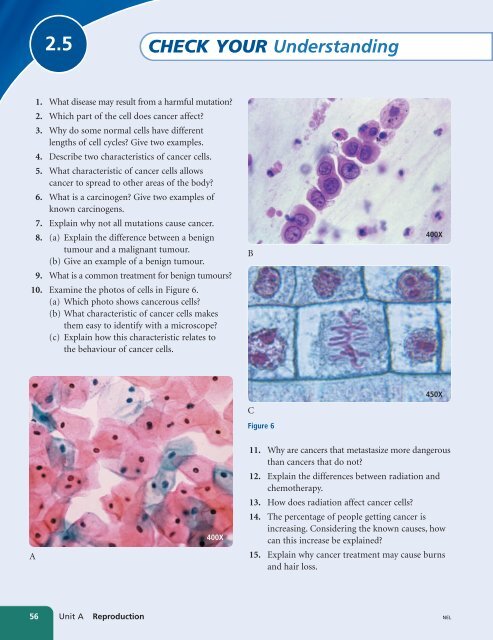Unit A Reproduction
Unit A Reproduction
Unit A Reproduction
Create successful ePaper yourself
Turn your PDF publications into a flip-book with our unique Google optimized e-Paper software.
2.5<br />
CHECK YOUR Understanding<br />
1. What disease may result from a harmful mutation?<br />
2. Which part of the cell does cancer affect?<br />
3. Why do some normal cells have different<br />
lengths of cell cycles? Give two examples.<br />
4. Describe two characteristics of cancer cells.<br />
5. What characteristic of cancer cells allows<br />
cancer to spread to other areas of the body?<br />
6. What is a carcinogen? Give two examples of<br />
known carcinogens.<br />
7. Explain why not all mutations cause cancer.<br />
8. (a) Explain the difference between a benign<br />
tumour and a malignant tumour.<br />
(b) Give an example of a benign tumour.<br />
9. What is a common treatment for benign tumours?<br />
10. Examine the photos of cells in Figure 6.<br />
(a) Which photo shows cancerous cells?<br />
(b) What characteristic of cancer cells makes<br />
them easy to identify with a microscope?<br />
(c) Explain how this characteristic relates to<br />
the behaviour of cancer cells.<br />
B<br />
400X<br />
C<br />
Figure 6<br />
450X<br />
A<br />
400X<br />
11. Why are cancers that metastasize more dangerous<br />
than cancers that do not?<br />
12. Explain the differences between radiation and<br />
chemotherapy.<br />
13. How does radiation affect cancer cells?<br />
14. The percentage of people getting cancer is<br />
increasing. Considering the known causes, how<br />
can this increase be explained?<br />
15. Explain why cancer treatment may cause burns<br />
and hair loss.<br />
56 <strong>Unit</strong> A <strong>Reproduction</strong><br />
NEL

















